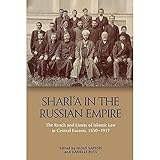Sharīʿa in the Russian Empire : The Reach and Limits of Islamic Law in Central Eurasia, 1550-1917 / Paolo Sartori, Danielle Ross.
Material type: TextPublisher: Edinburgh : Edinburgh University Press, [2022]Copyright date: ©2020Description: 1 online resource (384 p.) : 1 B/W illustrations 5 B/W tablesContent type:
TextPublisher: Edinburgh : Edinburgh University Press, [2022]Copyright date: ©2020Description: 1 online resource (384 p.) : 1 B/W illustrations 5 B/W tablesContent type: - 9781474444293
- 9781474444316
- 340.590947 23
- online - DeGruyter
| Item type | Current library | Call number | URL | Status | Notes | Barcode | |
|---|---|---|---|---|---|---|---|
 eBook
eBook
|
Biblioteca "Angelicum" Pont. Univ. S.Tommaso d'Aquino Nuvola online | online - DeGruyter (Browse shelf(Opens below)) | Online access | Not for loan (Accesso limitato) | Accesso per gli utenti autorizzati / Access for authorized users | (dgr)9781474444316 |
Frontmatter -- Contents -- Contents -- Introduction: The Reach and Limits of Sharīʿa in the Russian Empire, c.1552–1917 -- 1 Islamic Education for All: Technological Change, Popular Literacy and the Transformation of the Volga-Ural Madrasa, 1650s–1910s -- 2 Taqlīd and Discontinuity: The Transformation of Islamic Legal Authority in the Volga-Ural Region -- 3 Debunking the ‘Unfortunate Girl’ Paradigm: Volga-Ural Muslim Women’s Knowledge Culture and its Transformation across the Long Nineteenth Century -- 4 Between Imperial Law and Islamic Law: Muslim Subjects and the Legality of Remarriage in Nineteenth-century Russia -- 5 Islamic Scholars among the Kereys of Northern Kazakhstan, 1680–1850 -- 6 Tinkering with Codification in the Kazakh Steppe: ʿĀdat and Sharīʿa in the Work of Efim Osmolovskii -- 7 Taqlīd and Ijtihād over the Centuries: The Debates on Islamic Legal Theory in Daghestan, 1700s–1920s -- 8 Kunta Ḥājjī and the Stolen Horse -- 9 What We Talk about When We Talk about Taqlīd in Russian Central Asia -- 10 Take Me to Khiva: Sharīʿa as Governance in the Oasis of Khorezm (Nineteenth Century–Early Twentieth) -- Index
restricted access online access with authorization star
http://purl.org/coar/access_right/c_16ec
Studies the formulation, transmission and application of Islamic law under Russian colonial rulePresents the theory and application of Islamic law in the Volga-Ural region, the Kazakh Steppe, the north Caucasus and Central Asia from the 1550s to 1917Draws comparisons between Islamic law in Russia and elsewhere in the colonial worldBased upon important, but largely unstudied print and manuscript sources in Arabic, Persian and the Turkic languagesBrings together the work of an international collective of scholars of Islam in RussiaThis book looks at how Islamic law was practiced in Russia from the conquest of the empire’s first Muslim territories in the mid-1500s to the Russian Revolution of 1917, when the empire’s Muslim population had exceeded 20 million. It focuses on the training of Russian Muslim jurists, the debates over legal authority within Muslim communities and the relationship between Islamic law and ‘customary’ law. Based upon difficult to access sources written in a variety of languages (Arabic, Chaghatay, Kazakh, Persian, Tatar), it offers scholars of Russian history, Islamic history and colonial history an account of Islamic law in Russia of the same quality and detail as the scholarship currently available on Islam in the British and French colonial empires.
Mode of access: Internet via World Wide Web.
In English.
Description based on online resource; title from PDF title page (publisher's Web site, viewed 27. Jan 2023)


